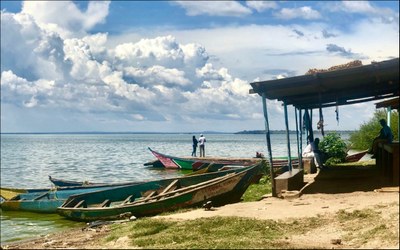Helping Programs that Treat Tuberculosis and HIV Address the Needs of Mobile Populations
 Many people living in the Lake Victoria region in sub-Saharan Africa depend on travel or migration for work or they fish the lake and so leave home for days at a time. This poses a problem for people with tuberculosis (TB), or HIV, or both, and for the programs aiming to treat them.
Many people living in the Lake Victoria region in sub-Saharan Africa depend on travel or migration for work or they fish the lake and so leave home for days at a time. This poses a problem for people with tuberculosis (TB), or HIV, or both, and for the programs aiming to treat them.
When people travel, they may not be able to visit their customary health provider and thus may not adhere to the long regimens required to treat TB or HIV. This economic reality—besides being risky for client health—may make treatment programs unsuccessful. For example, “universal test and treat” strategies for HIV response and the lengthy TB treatment require frequent visits to health clinics. To mitigate this issue, health programmers recently have mounted “migration-aware” and “mobility-competent” program responses.
With this reality in mind, the United States Agency for International Development (USAID) and the United States President’s Emergency Plan for AIDS Relief (PEPFAR) engaged MEASURE Evaluation and partners [1] to study mobility patterns, treatment outcomes, and the feasibility of regional client tracing strategies among people in care for HIV and/or TB in the Lake Victoria region, bordered by Tanzania, Uganda, and Kenya.
Health providers and managers can use the study results to improve treatment strategies for mobile populations; identify facilities serving those groups; and inform planning for improved cross-border coordination of health services, including medical record linkages, referrals, and defaulter tracing. Moreover, the findings may help to inform policies to improve HIV and TB prevention, care, and treatment in the region and beyond by addressing systemic barriers to positive outcomes.
Methods
To explore these issues, MEASURE Evaluation implemented a study with quantitative and qualitative components. Two groups of health facilities were selected as sites for the study: twelve facilities on the lake shore (including one island-based facility), where the number of TB cases were relatively high; and four island-based facilities where the number of HIV cases were high. Cohorts of interest were people in care for TB at shore-based facilities, people in care for HIV at shore-based facilities, and people in care for HIV at island-based facilities.
Data on those cohorts yielded 615 participants for whom there was enough data to analyze mobility for the quantitative survey. These participants were recruited for interviews to answer questions about mobility before and after diagnosis with HIV or TB and experiences receiving care. Information was also collected on country of birth to estimate the proportion of participants recruited at a country outside their country of birth, the average number of trips they made per month, the average total distance traveled outside their home district per month, the average number of nights spent away from home per month, and the average number of international trips per month.
The qualitative study included in-depth interviews with 16 staff members from the health facility sites who were asked to estimate the percentage of their patients who travelled. Twelve of these were able to provide estimates of the numbers of patients travelling while on ART and 14 who estimated the percentage who travelled while being treated for TB. A total of 41 community members participated in small focus group discussions, half of them male and half female. They represented a variety of community roles, including peer educators, village health teams, and members of community interest groups.
Although the assessed mobility metric is not strongly associated with access to care or treatment outcomes, participants in both the quantitative and qualitative surveys reported it was harder to access care and adhere to treatment when traveling. In fact, of the 20 patients who reported in qualitative interviews that they had missed their medications, nearly half gave travel-related reasons. In the quantitative survey, the top two barriers to HIV and TB treatment adherence reported were working hours and travel.
Findings
The most frequently reported barriers to ART adherence were work (23.1%), travel away from home (16.8%), forgot to take medication (14.0%), forgot to carry medication with them while traveling (8.5%), and lack of food (8.1%).
A unique identifier system might be one strategy to increase people’s adherence to treatment while traveling, as it could allow health providers access to health records across borders. Such a system would need to overcome concerns about data confidentiality, security, portability, and stigma. And unique identifiers are difficult to create and sustain across time, the study found.
Conclusion
Regional connectivity stimulates mobility and economic opportunity across East Africa and as cross-border connectivity grows, ongoing TB and HIV prevention and treatment efforts can benefit from adaptations. These include structural changes to health systems that would include regional, cross-facility linkage of patient records; new strategies for the provision of HIV and TB medications in quantities to last during extended or unexpected travel; and strategies to improve people’s access to health services when away from home. These strategies can improve the continuity of care for people living with HIV and/or TB in East African cross-border regions and in other regions that elect to work together.
[1] Local organizations—the Lake Victoria Consortium for Health Research: Uganda Virus Research Institute and the International AIDS Vaccine Initiative (IAVI); the Kenya Medical Research Institute (KEMRI); the Medical Research Council/Uganda Virus Research Institute and the London School of Hygiene and Tropical Medicine; and the Mwanza Intervention Trials Unit—partnered with MEASURE Evaluation on the study.












